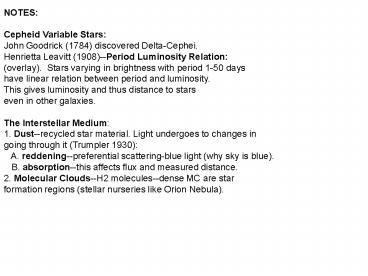NOTES: - PowerPoint PPT Presentation
1 / 18
Title:
NOTES:
Description:
NOTES: Cepheid Variable Stars: John Goodrick (1784) discovered Delta-Cephei. Henrietta Leavitt (1908)--Period Luminosity Relation: (overlay). Stars varying in ... – PowerPoint PPT presentation
Number of Views:49
Avg rating:3.0/5.0
Title: NOTES:
1
NOTES Cepheid Variable Stars John
Goodrick (1784) discovered Delta-Cephei. Henrietta
Leavitt (1908)--Period Luminosity
Relation (overlay). Stars varying in brightness
with period 1-50 days have linear relation
between period and luminosity. This gives
luminosity and thus distance to stars even in
other galaxies. The Interstellar Medium 1.
Dust--recycled star material. Light undergoes to
changes in going through it (Trumpler 1930)
A. reddening--preferential scattering-blue light
(why sky is blue). B. absorption--this affects
flux and measured distance. 2. Molecular
Clouds--H2 molecules--dense MC are star
formation regions (stellar nurseries like Orion
Nebula).
2
Cepheid Variable Stars John Goodrick
(1764-1786), deaf person, discovered variable
star Delta-Cephei at age 17. He died at age 22!
3
(No Transcript)
4
Henrietta Leavitt (1908)--Period Luminosity
Relation Stars varying in brightness with period
1-50 days have linear relation (in logarithmic
plot) between period and luminosity. This gives
luminosity and thus distance to stars, even in
other galaxies.
5
The distance ladderCepheids take us out to about
25 Mpc
6
We now want to study the interstellar medium!
7
The Interstellar (between the stars) Medium
1. Dust--recycled star material.
8
Dust grains in space are very complex!
9
1930 Trumpler observes open clusters. Finds
dust is dimming and reddening spectrum. He is
able to calculate influence of dust on apparent
brightness. This changed distance to stars
radically!
10
- reddening--preferential scattering-blue light
- (why sky is blue).
11
Why the sky is blue.
12
Reflection nebulae are blue for the same reason.
Nebula in Cepheus
13
B. absorption--this affects flux and inferred
distance.
14
2. Dense Molecular Clouds--H2 molecules--star
formation regions.
Possible origin Monatomic H atoms meet in chat
room (on dust grain) to make H2
15
Dense molecular clouds form stellar nurseries
like Orion Nebula
16
Proper Motion (angular movement of star) The
star with the largest proper motion is called
Barnard's Star. It moves 10.3 seconds of arc per
year Comparison of two photographic plates
taken 22 years apart shows evidence of its real
space motion (denoted by an arrow).
17
Proper motion gives transverse velocity Doppler
shift gives radial velocity Pythagorean theorem
then yields space velocity.
18
Radial velocity is in the line of sight (a line
from the observer to the star). Transverse
velocity is across the line of sight.































